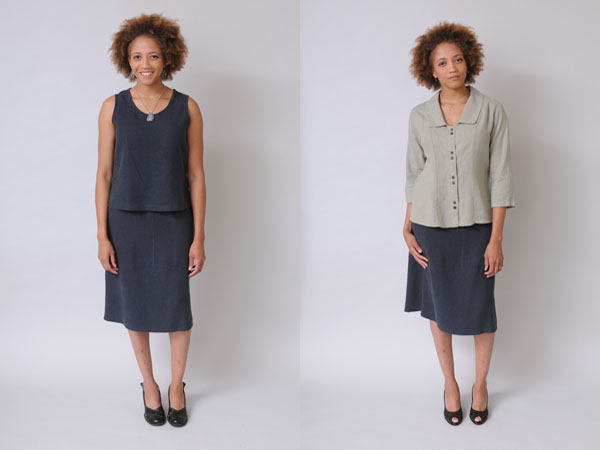What is slow fashion anyway?
Posted by Rose on 25th Feb 2020
Our language tilts towards treating the word “slow” as a negative — something to be avoided or fixed. Think, for instance, of the term “slow-witted.” But there’s another sense of the word that has been growing in our culture recently.

Sympatico makes its line of versatile basics sustainably.
What is slow fashion?
The slow fashion movement aims for greater connection between makers and consumers and about how creations and wardrobes impact the planet.
There’s an intentional slow movement afoot these days that kicks traditional, negative connotations to the curb. Today we hear a lot more about simply being present in the moment; focusing our attention on our work and relationships. In some spiritual practices, such mindfulness is a prerequisite to meaningful relationships.
Why is slow fashion important?
Slow fashion is important because it reconnects us to how we live our lives and how we affect the world.
The slow food and slow fashion movements also aim for greater connection between makers and consumers. The one quality that slow fashion seeks from both makers and buyers is enhanced awareness. Awareness on the part of the maker about how her creations impact the world; awareness on the part of the buyer about how her purchases and consumption impact the planet.
How did the slow fashion movement begin?
It was based upon the Slow Food movement which stresses local, transparent and green.
Where once we were all physically and emotionally bound to each other in intimate communities, we now largely exist in vast or virtual communities that may lack the connection vitamins we’re wired to thrive on. Likewise, our food supply has grown increasingly distant and unconnected with our lives. We’ve incurred a loss of intimacy with things like the soil that gives us sustenance as well as the materials and methods that offer us shelter.
The same could be said for fashion. Many of us have lost touch with the methods and materials needed to make clothes. Long before there was such a thing as ready-to-wear, off-the-rack clothing, women either made their own wardrobe or employed a seamstress or dressmaker. These were often someone the buyer knew, maybe a neighbor or a relative. The process of obtaining women’s fashions was far more transparent than it is today.
Why choose slow fashion over fast fashion?
With today’s global marketplace for apparel, it is a challenge for concerned consumers to break through the lack of transparency typical of fast fashion.
What is fast fashion?
Fast fashion is a contemporary term used by fashion retailers for designs that move quickly from the catwalk to fast-fashion retailers’ stores in order to capture the latest trends and fads.
Why is slow fashion so important?
In the past 30 years, the conversation about climate change has become more and more urgent. We are also facing crises of a dramatic surplus of waste and unsafe chemicals, resulting in overflowing landfills, and looming shortages of resources, such as fresh water and energy.
Slow fashion embraces a way of life focused not only on environmental health and conservation, but the health of people and their communities. The goal of slow fashion is to meet our apparel needs without compromising the ability of future generations to meet their own needs. The apparel industry produces more than 5% of all man-made greenhouse gas emissions, not to mention the incredible amount of water, energy, and resources consumed in the production process of fabrics such as polyester, nylon, and rayon.
In order to limit increases in global temperatures, greenhouse gas emissions need to fall to an astounding ZERO percent by the year 2050, which means we have a lot of work to do, especially in the fashion industry. The sustainable clothing movement that fuels slow fashion has provided a new era of clothing that emphasizes environmental conservation, social responsibility, and economic development. Because they require fewer harsh chemicals and use less water and energy in the growth and production process, sustainable natural fibers provide an ethical solution to a growing problem.
How can I support slow fashion?
These are the things to look for:
- Low-impact fabrications: Is it made of non-toxic, sustainably produced or recycled fibers?
- Energy efficiency: Does the clothing manufacturer use processes that minimize the energy used to make it?
- How well made is it?: Is it long-lasting and thus, replaced less? To be considered ethical clothing, it should reduce the impacts of producing new garments.
- Reuse and recycling built into the garment: Is it designed to offer either a commercial “afterlife” or to biodegrade?
- Design impact: Does the manufacturer consider the product's entire carbon footprint?
- Closed-loop manufacturing: Does the maker reuse materials in continuous closed cycles?
- Renewability: Does the clothing maker use materials from renewable, sustainably managed sources?
- Robust eco-design: Is it made in a manner that controls and limits pollution?
Where can I buy slow fashion and how does it relate to crafts?
Seek out artisanal makers and manufacturers who are transparent about the materials and methods they use. Look for apparel producers who make concrete efforts to sustainably source their materials and who abide by fair labor practices. For example, at Sympatico I take great care to source sustainably made materials and support companies that treat workers equitably and offer fair pay. I detail some of the lengths I go to in this effort here.
Share:





